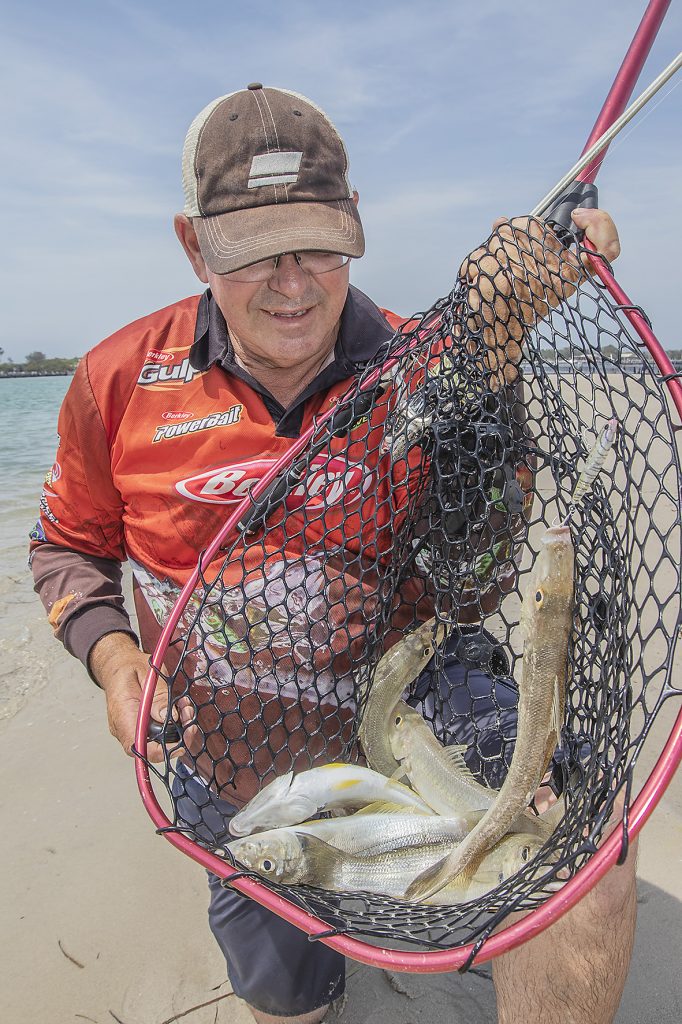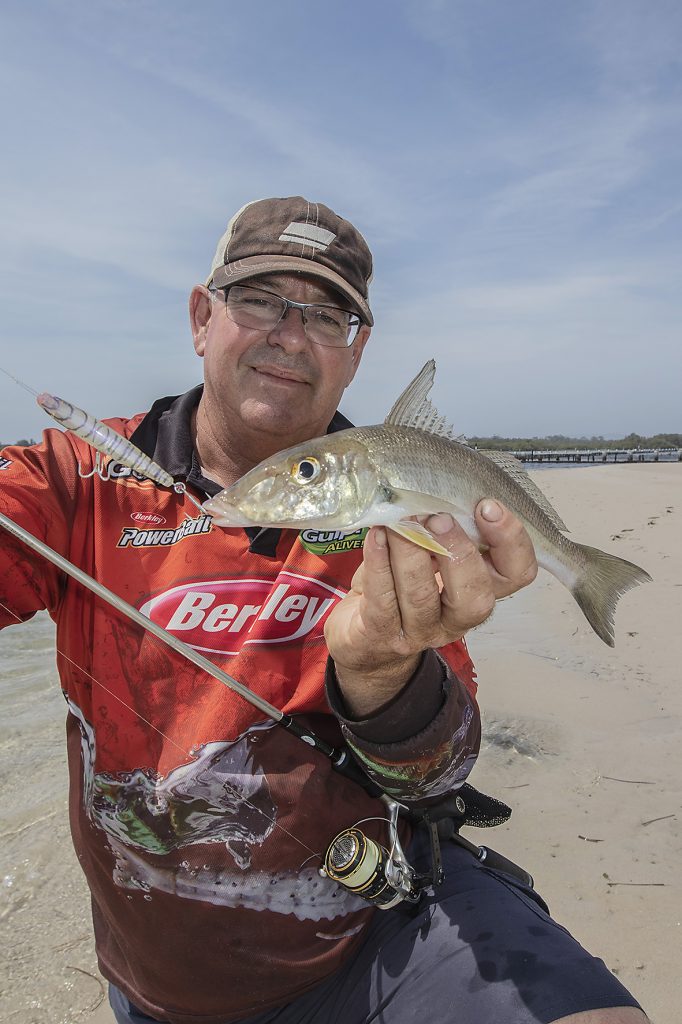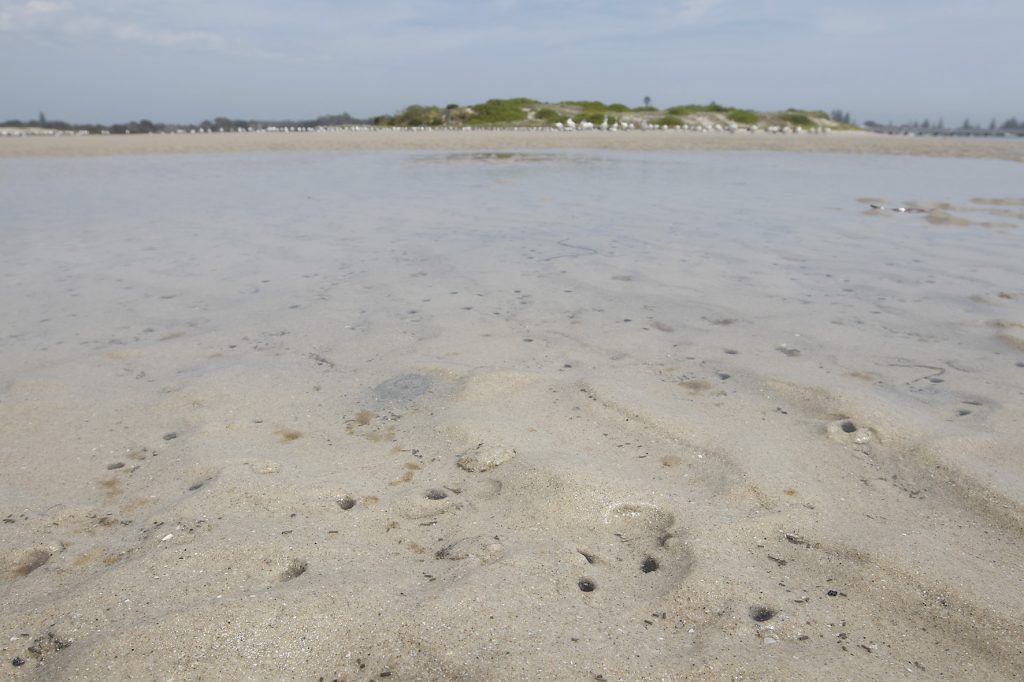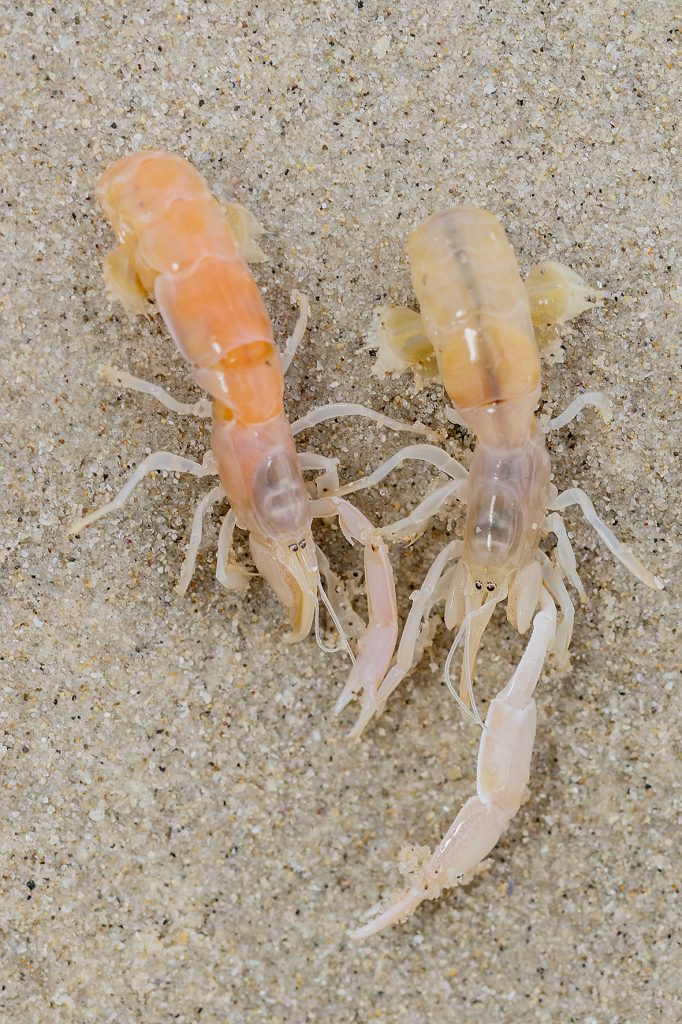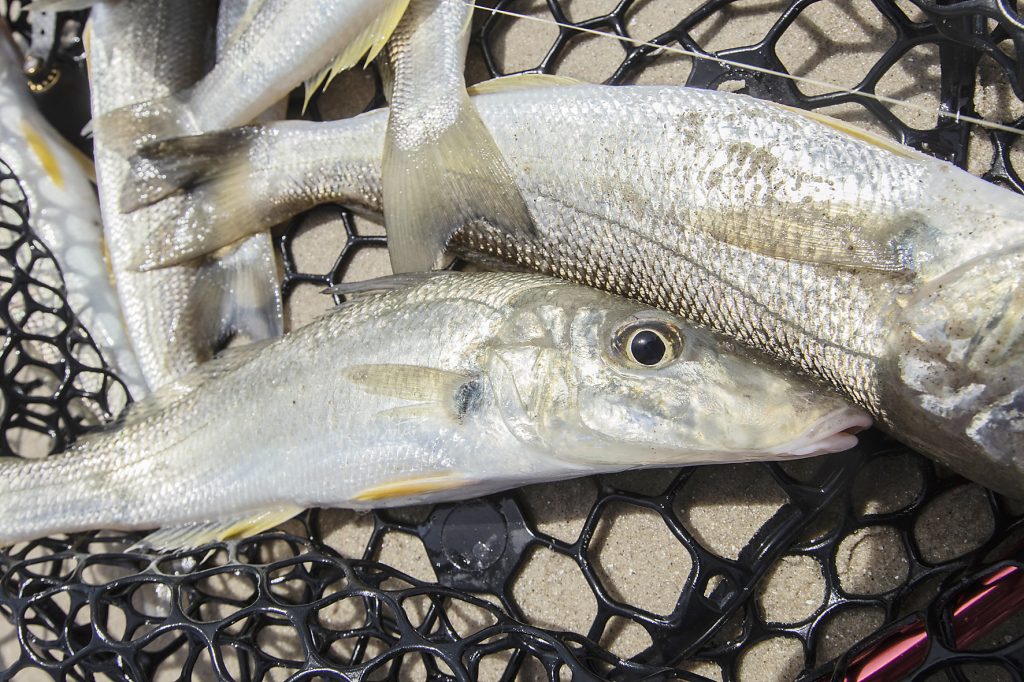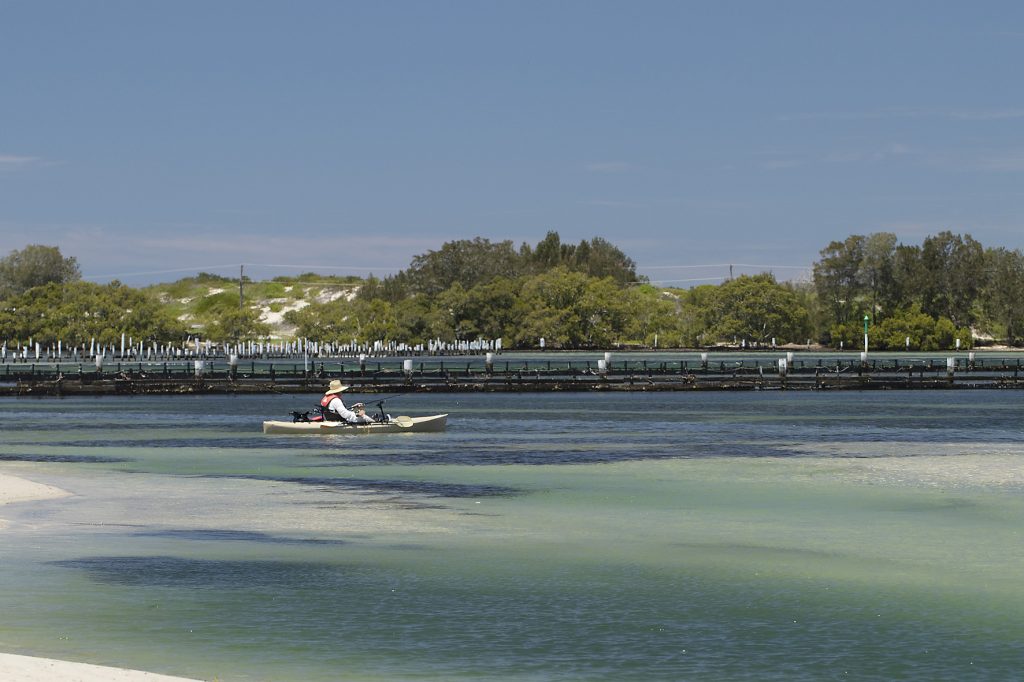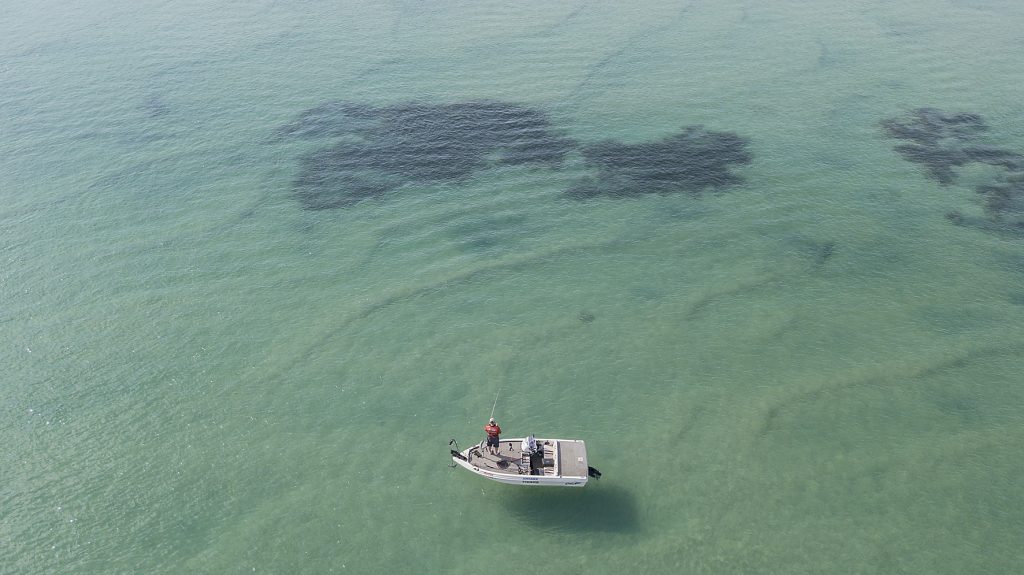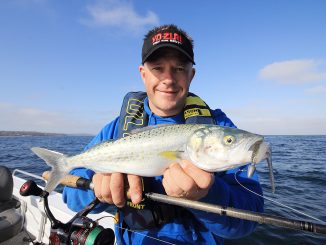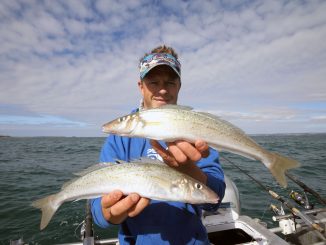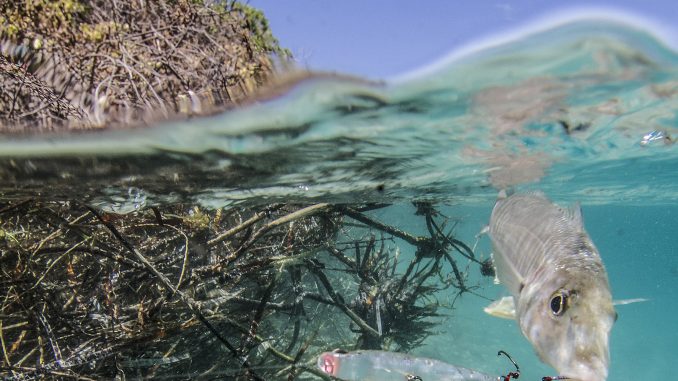
by David Seaman •
Whiting are not a species many of us think about until summer hits and the sand flats erupt with life. As a kid I remember wading the flats, casting for flathead and always having a trailing line of whiting sifting the disturbed sand as I moved, and they followed closely.
The small fish showed no fear or precaution, unlike the larger shadows that sweep the sand well behind my path and disappeared with every overhead shadow. Big whiting are a fish that is inquisitive but cautious but, thankfully, suckers for baits of worms, prawns and yabbies. Their worth as a sport fish wasn’t realised until the regular use of topwater lures over the flats and weed beds that attract them during summer. More than a decade later, and with all manner of surface offerings, the whiting have become a consistently viable target for anyone willing to try this technique.
Sand whiting are the largest of the whiting species that occur in NSW, with the smaller trumpeter whiting predominately targeted on baits. From the end of October into the summer months, the trumpeters carpet the estuary seabed and are fished for from boats with a light, two hook paternoster rig. Not growing much bigger than 30cm long, the fish aggregate in the estuary where their spawning mass provides anglers with a great opportunity to collect succulent 20 small whiting in an hour or less.
The sand whiting has a summer distribution from the local beach gutters to the upper tidal water of the estuary, although they are mostly targeted in the clear water of the lower estuary. They favour the channel edges and deeper pockets of water during the low tide and advance to the flats as the rising water provides access. While the whiting are always looking for a feed and won’t pass up a live bait, it is the rising water that triggers their hunting instinct and when they are most susceptible to a variety of angling techniques, including lures.
WHITING HABITS
Apart from the incidental capture of whiting on soft plastics, hardbodies and vibes, the most consistent luring method is skipping poppers or pencil thin surface lures over the flats. While the tidal flats can be productive on the run-in tide over summer, there are moon phases that provide an increase in the chances and catch rate once they all fall into place.
One reason the whiting are feeding on the surface is not because they are targeting surface prey, in fact it is the opposite. Whiting will drive their heads into the sandy bottom in search of yabbies, worms and, during summer, prawns. Prawns rest, concealed in the sand, during daylight hours and emerge at night to continue their journey to the sea on a run out-tide to spawn. As the whiting plunge the sand the prawns bolt away on the surface where the whiting follow in hot pursuit, and the skipping prawn is consumed in an upwelling of water. Our surface lures merely represent a prawn or baitfish that got away from the bottom and is bolting for its life.
The new moon period offers two significant benefits to whiting fishing. It increased movement of prawns through the dark period of the month and the gravitational effect produces higher water level over the flats. This is the peak time for whiting in general, and should also culminate in better sessions on the lures. It has always been a tradition to throw a live prawn baited handline over the side of the boat whenever I go prawning during the dark. It is a great way to fill a bag with whiting and a few flathead and give you an understanding of the opportunistic feeding behaviour the whiting can exhibit. My general formula for whiting is a run out-tide, where I’ll stick to the edges of the flats and concentrate on the deeper channels. On a run-in tide I’ll stick to the edge of the channel and concentrate on the flats as the water pushes over the sand and provides access.
TECHNIQUES
The whole surface lures for whiting became popular about 10 years ago, but was well used years before the fishing media were aware of it. This day and age, with social media, fishing phenomena can be disseminated instantly to everyone interested, with videos to demonstrate the styles. There are two distinct styles of surface luring – poppers with large cupped faces and a stubby tapered body and slender skid bait types, with a bevelled tow point and long, thin profile. Both are used to represent the frantic escape of a baitfish or prawn, however each is handled and retrieved a different way.
Poppers of around 40mm long are worked over the flats and weed patches with a slow, short, downward strike of the rod tip, whereas, a long, thin lure like the 3B Popdog or Bassday Sugapen are trafficked across the water sometimes at speed like a botched cast retrieve. The whiting can get in such a mood that the faster you retrieve your lure the more interest they show in it, and if you slow or stop your retrieve, the whiting simple dissolve from sight and disappear once again. This is where a good pair of polarised sunnies pay for themselves. With the aid of a head sock or other means of minimising light leakage behind the lenses, it is possible to see the whiting, and their shadows, chasing the lure before rising to the surface and slashing at it. It depends on the depth and clarity of the water, the angle of the sun and mood of the fish, but with experience you’ll soon know what to look for in a variety of situations.
TIMING
By far my favourite scenario is fishing the end of a rising tide, casting with the wind over the top of water 0.3-1.2m deep, particularly along a channel or drop off onto a sand flat, and the sun directly above me. It is insane the numbers of fish that hold on rippled water and the more fish that are there the more competition it creates, and the more haphazardly the whiting will bite.
While the bulk of the fish move around in loose schools, the larger fish tend to be drifters that chase off smaller fish, especially during periods of spawning aggregation. Anecdotally, many big whiting fall to surface lures and soft plastics fished for bream around the oyster lease structures, so a few prospective casts between racks isn’t such a bad idea if the situation presents itself. The sandy areas under the leases provides good foraging and the lease structure offers overhead protection.
The only retrieve technique advice that is valid, is to mix it up and find what works for the prevailing conditions. You may find on the windless morning, with the water like glass, a slower popping retrieve with a pause works best, while with a slight wind chop the fish may want fast food that skips across the surface making it a challenge to catch.
A good breeze is your friend, provided you position yourself so you’re casting with it. This extends your reach with each cast and effectively prospects more ground. Casting with the wind on a 2.1m, fast-tapered rod and 4lb braid helps to project your lure further, and by targeting the line release at about an 11 o’clock angle the wind will carry the line and lure into the distance. A two-handed cast will also squeeze an extra metre or two from your efforts by controlling the rod wobble and as a result, control line slap up the blank.
Leader strengths are a balance between, light enough so it doesn’t weigh on the nose of the lure, but strong enough to deal with contingencies like the large flathead and bream that share and hunt the flats with the whiting. Using a fast retrieve you eliminate 80% of the non-targeted species, so a leader of 4lb is sufficient. Slower retrieved lures may need 8-10lb, just to be safe. Where the lure is fitted with a split ring on the tow point, it pays to remove it if using leaders over 8lb and tie a loop knot. Lighter leaders are subtle enough not to restrict movement, so can be tied straight to the lure.
LURES
While there are many lures on the market that will work on whiting, I think the frontrunner for consistency would have to be the Bassday Sugapen in either the 70-95mm size. There is just something about the profile and action of the lure, whether skipped or walked that excites the fish. Add to that the great colour and patterns available and they are a must-have for whiting fishing.
Other lures that make the grade are the Berkley 3B Popdog and Prawn Dog, Lucky Craft Sammy, and Bevy Prop 55, which I love for the extra fast retrieve.
The way the whiting are built, with a shorter bottom jaw, indicates their habit as a bottom feeder, so the task of taking a lure off the surface is sometimes difficult for them. You can have half a dozen fish belting a treble fitted lure and still have no luck of a solid hook set. The answer is to wing a pair of short assist hooks from at least the tail of the lure. The single hooks attached on a length of braid dangle well beyond the lure and account for the frantic slashing and surges the fish make. The hooks should be at an offset length so as not to impede each other and provide the best opportunity to snag the Freddy Mercury overbite.
While it is much easier to fish from a boat and use SpotLock or anchor mode on an electric to hold position, it is by no means the only way to access good fishing. Wading the flats is, I think, far more enjoyable and can be much stealthier approach. The fact that you are searching shin to knee deep water lends itself to parking the boat and going for a wander, as you would for a flathead spin.
BAIT
When it comes to certain species the bait angler is often forgotten, but are just as important and their lure chuckin’ counterparts. If I was looking for a decent feed of whiting, my preference would be to use bait in the last of the run-out tide in channels and gutters surrounding the flats.
Yabbies and beach worms are key to bait selection and this time of year, and local tackle suppliers should have live worms for sale.
The rig used for whiting is a simple running ball sinker, sufficient to make the bottom, and a metre or so of 4-6lb leader tied to a no. 4 bait holder hook for the yabbies and long shank for the worms. A short sheath of red tube on the leader or a red bead acts as an attractant to the fish, but isn’t essential, as the current disperses scent as the fish nose up into the flow.
The same rig can be used at night with worms, yabbies and live prawns and in the same general areas of drop-off, channels and flats. Another area worth a look for whiting at night is the area around lit bridges and other structure. It is also an area you’ll find plenty of flathead, so up the leader strength for the mixed bag combo.
Beaches are a popular place to catch whiting and a single or double hook on a running sinker or paternoster rig, and this is as basic as it gets. Long, light rods and a threadline outfit loaded with 8-10lb braid or mono is sufficient to cast the baits into the gutters of deeper water, or as close as the back of the rolling surf line. Beach worms are the best bait along the sandy strip, although live yabbies are a close second, believe it or not. Pipis collected on the beach you intend to fish are permissible as bait only and a restriction on transporting them beyond high tide line is in effect.
Other species that raid your baits will include toads, bream, dart, silver trevally, tailor and sometimes small mulloway. That’s not a terrible list of beach possibilities, and the whiting are almost always on the hunt along the beach, but a rising tide is premium.
So no matter where you encounter whiting, they are a prized but fiddly table fish that are well worth the trouble if you manage a few big ones. The time to fish for them is now and you won’t know if you don’t give it a go. It’s the best way to spend a few lazy hours in the salt!

